“The eye is always caught by light, but shadows have more to say.” -Gregory Maguire, author of Wicked: The Life and Times of the Wicked Witch of the West
What exactly is meant by this word, “shadow”? An area of darkness, of less light, perhaps? The very concept of shadow is an artificial convention, which can lead to limiting mischaracterizations of the underlying reality. For instance:
Everything in shadow is not darker than everything in the light
In daylight, for example, a white sheet in shadow, especially if it’s exposed to the sky, is going to be very light—lighter than a black surface in the direct sunlight.
Moreover, shadows are not “the opposite” of the light
In daylight, all the light is coming from a single source: the sun (unless you’re staring at your phone screen of course). In fact, it’s the same at night, because even moonlight is actually sunlight. That single light, which is essentially neutral (white) is making every single color you see in both the light and the shadows. If there are some cool shadows, it’s not because the sunlight is warm. In fact warm light can only make warm shadows (and on top of that, sunlight isn’t warm).
The truth is that (in reality and in your art) the light can be any color/temperature, and shadows can be any color / temperature. The color of something in the light is the color of that thing in the light, and the color of that thing in the shadow is the color of that thing in some other light. These lights are not directly related or connected. Warm / cool relationships in paint (digital or otherwise), which I personally us a lot, are nonetheless artificial, and therefore a matter of artistic choice.
Sixth, and lastly, what do we mean by “less light” anyway?
Humans confuse chroma (or saturation) with illumination. Chroma and saturation refer to hue purity, or hue narrowness, which, critically, means less light, not more. If you evaporate all the water from a cup of seawater, for example, you’re left with pure salt. You don’t have more salt or more anything—you have less. But you have salt whereas before you had seawater. Is this making sense? It’s late, I’m tired. Anywho, generally the main light is neutral, or is neutralized by our perception. So almost always it contains a wide range of colors (Paradox #1: the more colors light contains, the whiter it is). The narrower the bandwidth of the light, the less light, but the more color. This works in our favor in terms of getting light and color into shadows.
The inverse is not necessarily true: simply reducing light does not necessarily or automatically increase hue purity. However, hue purity is only possible in reduced light, and that is the vital point for our understanding of light in shadows.
Thirdly, shadows have more color, because they have more, colored, lights
Light that makes it into the shadow world has necessarily passed through or bounced off of something. And unless the reflecting/ refracting surface has perfectly neutral reflective qualities, the light that emerges will have color. This is obvious: when we perceive colored things we are really perceiving filtered light, which in most cases began as neutral. All those colored things reflecting light in turn serve as secondary light sources, as light sources of the shadow world.
As such, a given object can appear as a variety of colors in (different parts of the) shadow world, but only one in the light. For example, a white sheet on a clothesline will be essentially white in direct sunlight, but in shadow in that same setup it will appear blue where lit by the sky, green where lit from light bouncing off the grass, red from light bouncing off of Dan’s long johns next to it on the clothesline, etc.
In conclusion… Treating shadows as subordinate to the world of (the direct) light, risks sacrificing a rich source of artistic expression and interest. Really there is more going on in shadow world than in the light world.
All we can say for sure about what “shadow” means is “not directly illuminated by the main light.” Then we might ask, “What is a main light?” Much of this ends up sounding circular: if “shadow” is an artificial concept, then why I am talking about the shadow world as if it is a reality, a world? Because many environments, and, importantly, daylight, take the form of a single, focused, very bright light source, which (being singled and focused) does not reach everywhere. The result is a world of one powerful light, and a world of many non-powerful lights, most of which are reflected or refracted instances of that big bright one.
The crucial thing is both worlds are worlds of light and neither is more important for picture making or for human visual perception. And they don’t normally influence each other, though we often choose to relate them to one another when we compose pictures. In reality, even though the borders of the shadow world are determined by the big bright light, its nature is not.
I’ll also talk about the shadow world as playing by its own set of rules… but in reality, it doesn’t. The rules are the same. Light is light. Light shines through and bounces off of things. That’s all. But because we make this division between light and shadow, we must talk about what generally happens with a single, bright light and what generally happens with a bunch of not so bright lights.
Sunlight cleanses…
…so the weird (interesting!) s**t can only live in the darkness, under rocks and at the bottom of the sea. That’s the shadow world.
The direct light of the sun is basically a neutral light coming from a single direction. Parallel beams. Ho hum. A red apple in sunlight is… red. Snore. A white piece of paper is… white, yawn. In fact the only reason we call these things “red” and white” is because that’s how they appear when there’s nothing special going on in terms of light. Wake me up when we start talking about the shadow world again.
The reason there is more going on in the shadow world is, paradoxically, precisely because there is less light. So every little piece of baby light trying to speak up manages to get its say and be heard. Those same little voices are trying to speak up in the direct sunlight too, but they are immediately DESTROYED by that giant fireball (and they don’t even get a saving throw).
There is a strong cultural and artistic bias about shadows and “shading.” Probably this is because most art and artists start by making dark marks on white paper. But reality is the opposite. We do not live in a world of light, “shrouded by darkness” here and there, but rather a world of darkness, illuminated here and there with bits of light. If you can see anything, there is LIGHT, because that is all you can see. So let’s not think of shadow as some kind of dimmer-blanket draped over parts of an environment, squashing out the light. And let’s not think in terms of what light does “as it moves into shadow.” Shadow, by definition, is exactly where that light doesn’t go.
Now, shall we be brave, and take a walk through this shadow world, to see what we might find?
A Journey in the Not-So-Dark
This is Hamilton Fraud (rhymes with “loud”, or so he claims), hawking Dr. Beasley’s Spectacular Sun-blocking Ointment (and general Cure-All).
To help with our study, Hamilton himself is blocking most of the sunlight. Being a shady character, he exists mostly in the shadow world:
Are these shadows consistent in some way? Are they cool, warm, low saturation / chroma? Not really. There’s a range of hue and value, and some very saturated colors in there. The shadow world is less consistent than the light world—because we humans have chosen to call the world of many lights “shadow” and the world of one light “light.”
Let’s look at a few of those many lights.
Ambient or surrounding light
In most environments there is a lot of light all around (“ambient” means “surrounding”). This can be from a specific broad source or be an amalgam of many sources.
In artmaking circles “ambient” is often used as a synonym for the light of the sky, because it is generally the dominant factor in surrounding light, and is one of the primary illuminator of shadows.
But the light of the so-called sky dome is not non-directional—it comes mostly from above, because the sky is not really a dome.
Sky light does not reach under things or into crevasses; it does not illuminate downward facing surfaces (undersides).
Next…
Reflected light
Reflection is the other main a lot of light gets into the shadow world.
This important factor is often underrepresented in picture making, especially when working from different refs and combining them, where the light reflecting from one ref to another has to be constructed. The other reason reflected light is sometimes ignored is that shadow color is equated solely to ambient light color (and is therefore monolithic). So we hear about “cool shadows” or “warm shadows”. But If you do even a little with reflected light it can dramatically elevate the illusion of light and form in your pictures, and give opportunities to incorporate more color in your picture overall. This is especially true when some of the reflected light is a different temperature than the ambient light. Then you get cool / warm contrast within the shadows.
Self-reflection
We could all use more of this… (ok, look, I wanted to call it “self-illumination” but that has a different meaning in CGI). This is a specific instance of reflected light, when the main light bounces from a surface and onto another part of that same surface that is in shadow, as happens frequently with folds in skin and clothing.
This causes the perceived surface color to become hyper-saturated, as the same wavelengths are repeatedly filtered out.
“Bounce” light
This is another noteworthy, specific instance of reflected light, because the ground presents a big, flat surface in opposition to the typical overhead light.
As such it can reflect a lot of light in the opposite direction of the sunlight and the sky light, thus illuminating the least lit areas of the subject with a single consistent light.
With all kinds of reflected light value and saturation are critical. If these are not balanced right the result is the appearance of patches of arbitrary color stuck onto the subject, vs. the illusion of light.
Shininess
Shiny objects in shadow can reflect very well lit objects (objects not in shadow) crisply and clearly, creating very bright spots within shadow areas. Remember, as long as the shiny object is not reflecting the main light (e.g. the sun) directly, then it is in shadow. It could be reflecting a white sheet that is in direct sunlight, though.
And then there’s…
Rim light(!)
This is the thin band of light that often shows up on the (shadow) edges of the subject.
By definition the edge of a form is where we are viewing the surface at a very low angle. That makes it a lot more reflective (Fresnell effect). And what’s it going to reflect? Typically the ambient light (though photographers and illustrators typically employ a specific, dedicated artificial light source to enhance and control rim light).
Rim light tends to be uniform in color because, like a highlight, it is reflecting the color of the light purely into the eye.
But rim light is not uniform in width (like a line or halo). Its shape is important for contributing to the illusion of form.
Rim light can be faked, exaggerated (abused to the point of being a gimmick) etc. Lots of room for improvisation here. But it can look gimmicky very fast, so I try to use it sparingly, just to pick out edges as needed.
And finally (for now)…
Subsurface Scattering
Officially known as subsurface light transport.
This is when the main light penetrates a translucent surface, causing the inner material to glow through the outer casing. This happens in far more subtle ways than I’m showing here, btw.
The glowing thing in turn becomes a new light source, typically intensely saturated, but with very little power / range.
And where there’s no light…
Occlusion
Occluded areas are the shadows within the shadow world—areas where little or no light reaches, typically when two surfaces contact each other. They are small, but they are still shapes.
These areas are necessarily dark, even approaching black, and are typically neutral in color / temperature (which is why indiscriminately putting color in ALL your shadows can kill the illusion of light, and why using any of Photoshop’s criminally misnamed “shadow” controls will not save you).
Creative Light(ing)
Even if you work closely from reference, it’s important to be able to create the illusion of light convincingly, so you can manipulate it to achieve your particular artistic goals, or at the very least fill in the gaps not provided by the reference(s). To that end, there are plenty of diagrams like this on the internets:
It’s accurate enough (ok, maybe not totally), but this kind of thing doesn’t help me much when trying to create convincing lighting from imagination, or improvising my own unique lighting schemes. In a single artificial light setup, e.g. a streetlight on a dark night, shadows appear flat and black. There is no visible distinction between “cast” shadow and occlusion—because there is hardly any ambient light. So when it comes to the real time performance of painting it needs to be much simpler for me:
- All lights behave the same way (despite varying in color, intensity and location)
- There are a CRAP TON of light sources in any scene—I just need to know what they are
The fact that they can be named according to their manner of origin is not particularly important (to me). It’s not how I think of them when I paint, though I used some of those terms here as a gateway (hopefully) to lead you to a different way of approaching things if you want to try it. In fact I don’t even think in terms of things being “in shadow”—I think about everything I can see being in some kind of light. For me the concept of shadow is only meaningful as far as delineating a border between the world of one single light (as most pictures I do employ) and the otherworld of multiple lights. Within each world the rules are basically the same, though. If I’m doing a picture with multiple strong lights I do not think “shadow” except with respect to occluded areas.
The ONE THING we know about (this thing we have arbitrarily and simplistically decided to call) “shadow” is it is not exposed to the (thing we have decided to call the) main light. So just forget about that dang main light thing for a second, and look at everything that shadow area IS exposed to. What’s it facing? How close? What angle? What’s the angle to the viewer? These will guide you in filling your shadows with light.
For me it’s about understanding then inventing. Would that light from the ground really reflect this strongly all the way up to Hamilton’s snout? I don’t know. In fact, no one does, because we don’t know what is actually down there. Maybe it’s a piece of tan canvas or silk. I am only using the general principle of bouncing light for inspiration. I can apply it as much or as little as I want. The important thing is to understand these few simple principles, then develop your EYE as you experiment with them.
Don’t fall into the trap of believing shadow is somehow in opposition to the light. That’s fine as a compositional or poetic device if you want to use it, but it is limiting if you think it’s the way things are in reality.
Conclusion
We spend a lot of time futzing over how the light transitions to shadow, to turn form and such, then once we’ve crossed that barrier, “Eh, it’s all just “shadow” from here on. I’ve taken care of the important stuff. Maybe I’ll go one extra step and make the shadows all this or all that.”
What I’m trying to get you to do is see the shadow world in its own light (see what I did there?). Please don’t think of shadow as less light. Although on average shadows have a lower level of illumination, this is only a very small part of a very BIG story. This overemphasizing what is really a minor factor can lead to the assumption that shadows have less color, or less variation, or less chroma, or worse, are lightless or are always darker than everything in the light. In fact, shadows are areas with lots and lots of different light (so MORE light, in terms of variety, and intensity in the form of chroma / saturation which, as noted, for humans is a surrogate for illumination).
If you only consider a few of the lighting factors in the shadow world, those areas not directly exposed to the main light, but also not the deep crannies of occlusion that receive very little light, you will see this world in all its glory and brilliance, and hopefully come to appreciate its co-equal status with the vastly simpler world of the direct light.
Now, I need to go see a certain porcine peddler about getting my money back… My rheumatiz is worse than ever, and I seem to have developed a rash.



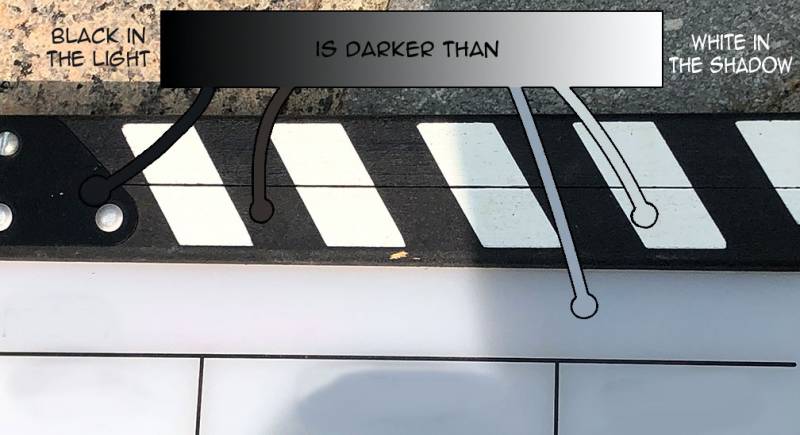

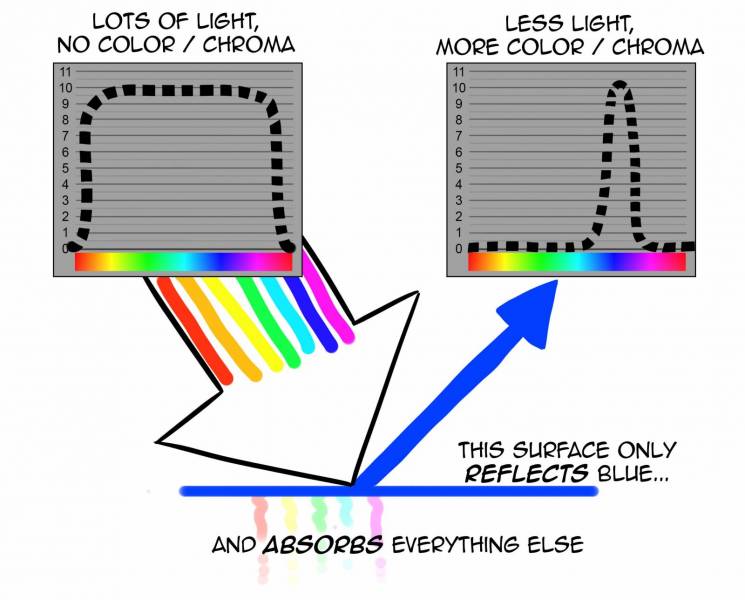
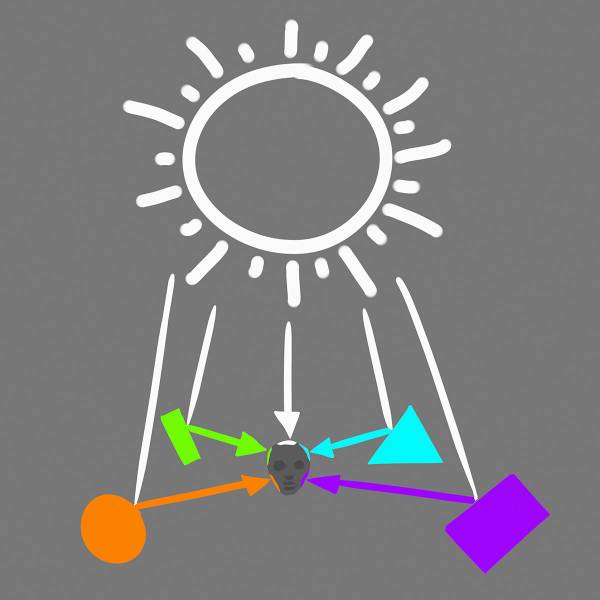


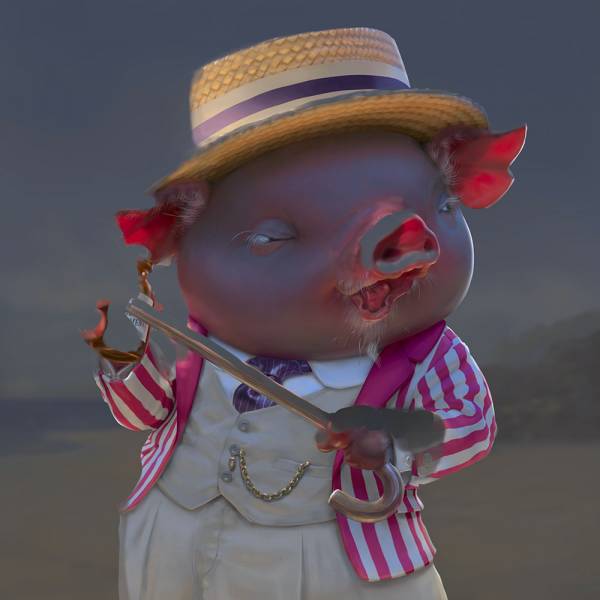
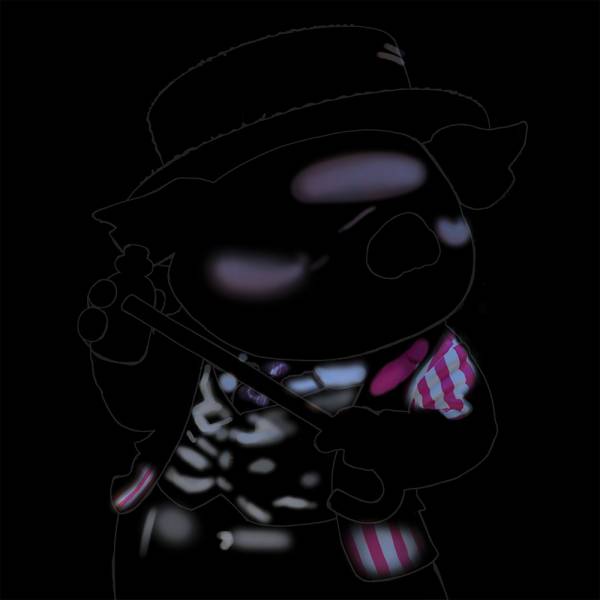

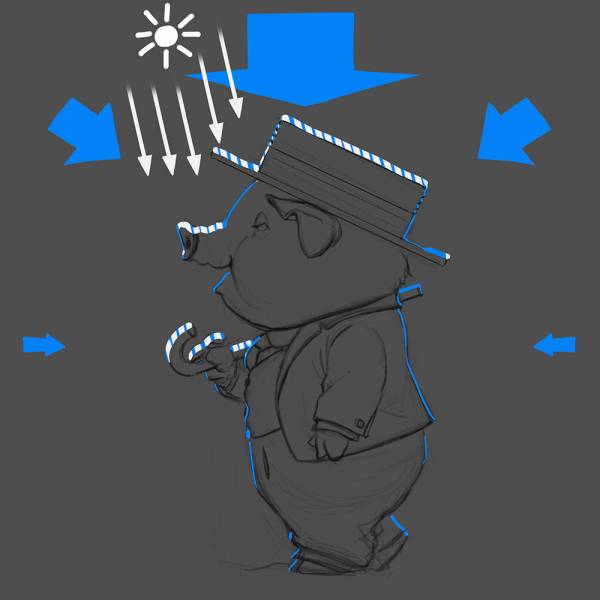
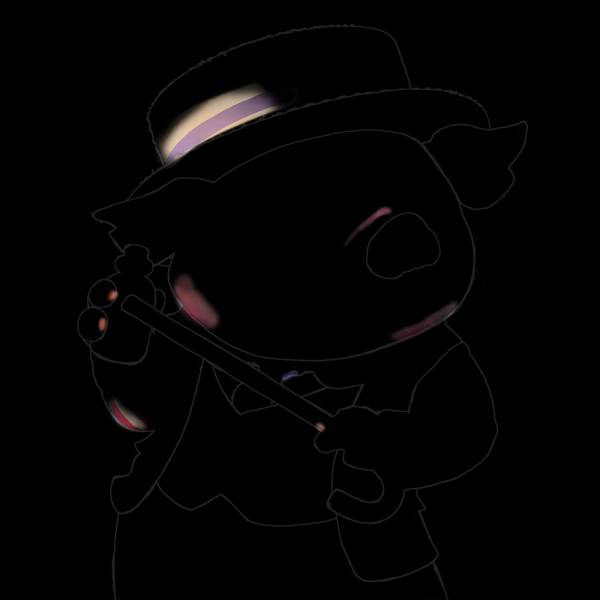
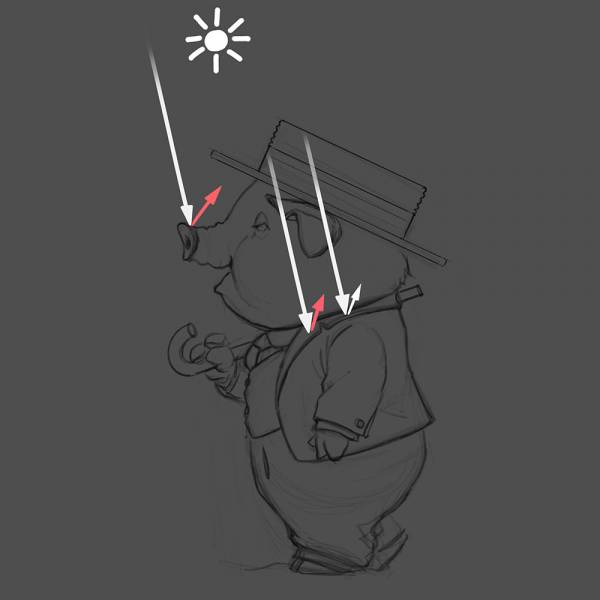

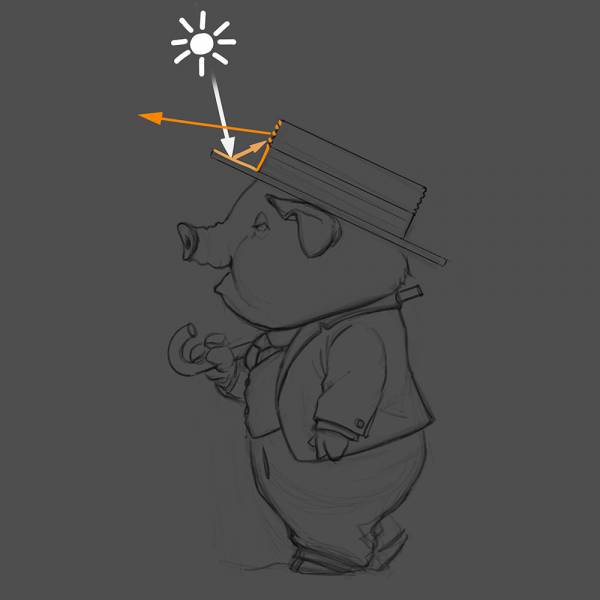

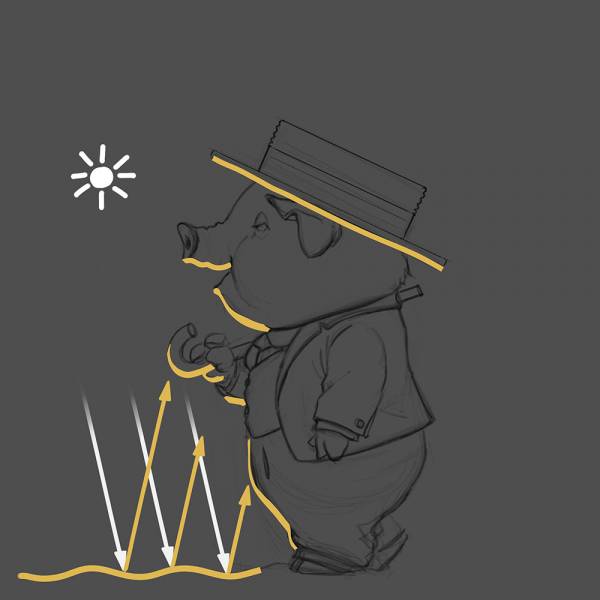



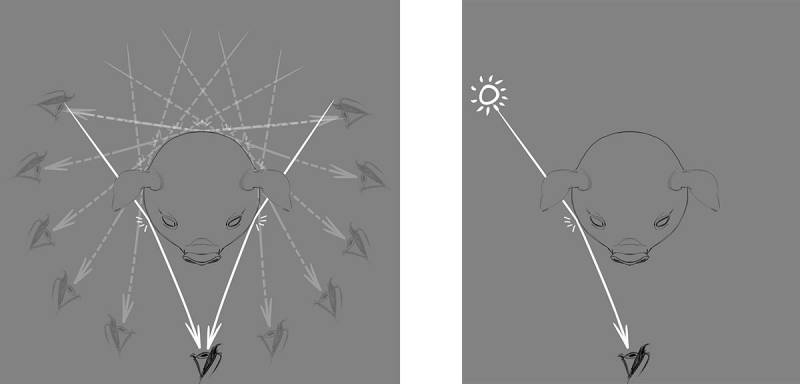

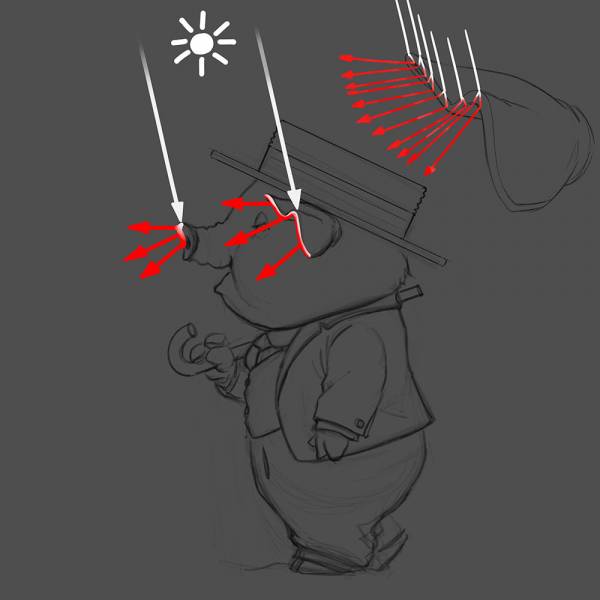





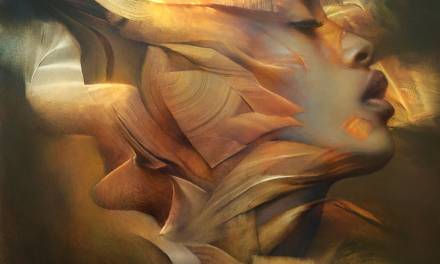

Phenomenal description! maybe the best concise discussion of understanding light and invention that I’ve ever seen! Thanks!
Glad you like, my friend.
This is such helpful info, extremely grateful for the time taken to write this out and explain it.
Thank you for the comment!
Great stuff as always!
Thank you!
YIKES, Chris! Great explanation and a wonderful post of discovery! I always love hearing complicated things simplified so well. It opens my mind. Anyway, loved it!
Oh, thanks so much for saying that, Greg.
Great article! I had been second guessing the “lightest shadow vs darkest light” for a while, since it seemed at odds with local colors. Really glad you included that
That “rule” is mostly used by landscape painters, where at least there is some consistency in terms of there being one main light, and so on. But with interiors, say, the concept of light and shadow is at best very different, and at worst completely meaningless. In interior setups where there are usually many different light sources, and lots of close, flat (white) reflective surfaces, we don’t see “cast shadows” so much, so when we say “shadow” we really mean only occluded areas. A person sitting in a room may have one light shining on one side of her face, and a slightly less bright light on the other. Is that side the “shadow?” Who can say? But it does strike me as odd that this rule would persist, when if you measure, say, the shadow a person’s head casts on their white t-shirt in the middle of the day, it can be like 85% on the value scale. I really don’t understand why artists continue to think in terms of light vs. shadow, as opposed to light + light + light + light.
HiyaChris.Thought the post was excellent.Just on this bit on lighter shadows.isnt it better to make them a bit darker to fit into the pattern of shadow for a stronger composition[.probably not thinking about it]
A very good post for such an amateur like me. Gives me things to think about. Thanks a lot.
So glad you liked it!
Wow, man! this is sooo deep! Thanks!